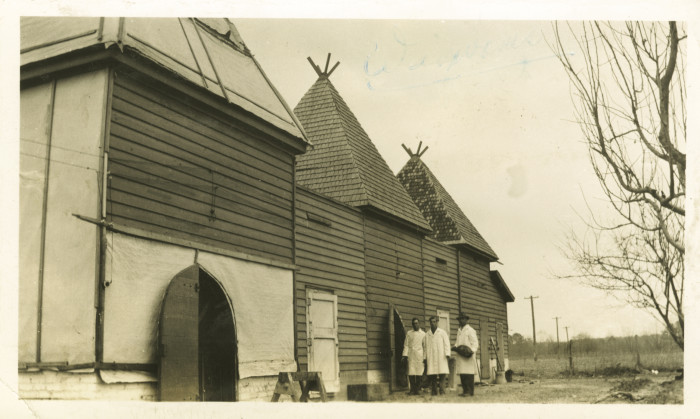Sam Edwards Makes Virginia Hams On Par With The Priciest Pork Of Europe. His Trick: Peanuts.
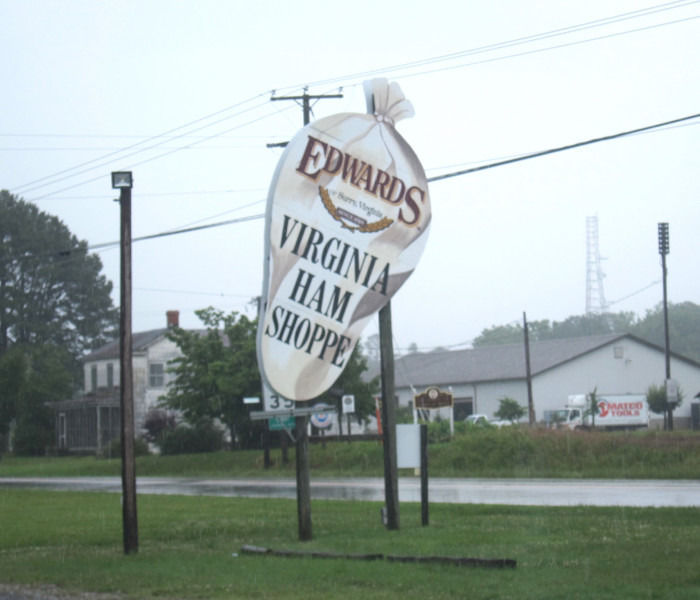
Sam Edwards III isn't trying to fool anybody, but he's no dummy, either. If you were to stop by his modest retail shop in Surry, Virginia, you'd think his operation is just a small country store. A giant sign shaped like a country ham marks the spot. Inside, the walls are decorated with old silk-screened cotton ham bags and dozens of championship ribbons garnered from county and state fairs over the years. Shelves and refrigerated cases are filled with jams and jellies, tea towels with cute smiling pigs and stacks of various varieties of ham, bacon, smoked sausage and other porky goodies. The place also serves a great ham sandwich and a pretty respectable slice of peanut butter pie from the small deli counter at the front of the shop.
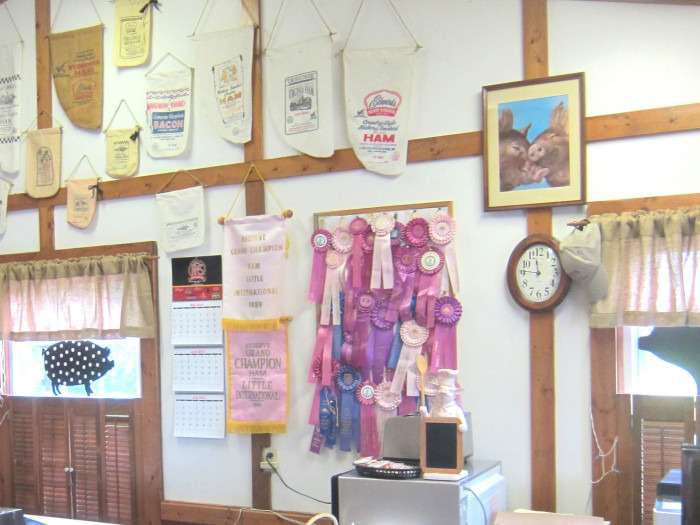
What you'd be missing if you didn't widen your field of view would be the large, modern facility located at the back of the property, a factory at which Edwards Virginia Ham produces more than 55,000 hams per year. Edwards has also opened another shop in the nearby tourist mecca of Williamsburg, where colonial history fans add his hams to their souvenir booty to drive the TSA dogs crazy when they sniff luggage. "The truth is," explains Edwards, "we had to build the store because people kept walking into our offices and asking to buy hams. We couldn't get any work done except pulling hams out of our inventory."
It's quite appropriate that a portion of Edwards's trade comes from tourists visiting Colonial Williamsburg, because that's exactly how the company started up in the 1920s. It wasn't always so easy to get to Williamsburg from the west side of the James River, and when Sam Edwards's great-great-grandfather Albert Jester started up a ferry service across the river, he cut a long time off of the trip to the suddenly popular tourist destination.
Jester's son-in-law (the original S. Wallace Edwards) also piloted one of the ferries owned by his wife's father. Being the entrepreneurial sort, S. Wallace recruited his wife, Oneita, to fix up some sandwiches made from hams they had cured in their barn at home. Hungry ferry passengers snapped up the treats to sate themselves during the voyage and soon began to inquire about purchasing whole hams. So S. Wallace constructed his first smokehouse to cure hams in bulk to satisfy the demand for his burgeoning mail order business.
As a nod to the Native Americans who first taught Virginia natives how to smoke and cure meat, Edwards designed his first smokehouse in the shape of a teepee, with a flap in the side to allow entry and to keep the smoke inside, plus a hole in the roof of the conical building to allow the smoke to flow out after it had completed its work of flavoring the drying pork shanks. In another homage, Edwards named his product line Wigwam Country Hams, a brand the company still uses today.
S. W. Edwards, Jr. (who went by the name Wallace) was born into the ham business in 1930 as the operation expanded to three more smokehouses and eventually built a larger operation on the 100-acre family farm in 1940. By the time Wallace became more active in the company during the 1950s, Edwards Hams had entered into the slaughterhouse and pork-processing business, a fact that complicated things.
"Before that, the USDA hadn't caught up with Surry yet," Sam Edwards recalls, "but since we are so close to Washington, D.C., it didn't take too long for them to get interested in what we were doing. My dad complained about some of their arbitrary regulations, like the fact that he had to back his car out of the garage before he could make sausage in there. Now we have two people working full-time to keep up with the regulations, and the USDA is on the premises every day."
Eventually, Edwards tired of the aggravation of the slaughterhouse and the associated paperwork and closed that operation down in the 1960s. Sam Edwards still wonders about the level of regulation of his business, though. "I don't know that I've ever heard of someone dying from a food-borne illness from country ham," he says. "I guess you could maybe die from choking on it."
Wallace continued to grow Edwards Hams while waiting for his son Sam III to graduate from the University of Richmond and join the business after summers working in the plant shoveling hickory into the smokers and cleaning out the sludge from the facility's massive grease trap. "Dad took the business from small to large by introducing scientific methods to figure out the best methods to replicate what Mother Nature contributed to the curing process," Edwards explains.
The traditional home method of curing meat involved putting up hams that have been packed in salt to limit bacteria growth in the fall and winter, when temperatures and humidity levels were low, and then smoking them to add flavor. Additional hanging during the warmer months allowed the ham to cure further and develop the delightfully complex flavors that make it so popular.
Sam Edwards remembers that his dad recognized that science could improve on the traditional methods. "Virginia weather can get way too hot and too cold for optimal curing," he says. "Over the course of years, Dad began to measure the variables of temperature and humidity to replicate the ideal conditions for creating the best products. But even after developing rigorous standard operating procedures, you still have to walk into the room and touch and smell the meat."
Edwards still practices MBWA (management by walking around), constantly moving among the 38 rooms of the curing house, which are set to different temperatures and humidity conditions depending on the product being cured and the stage of the process. "I can monitor the temperature and humidity levels from my iPhone, but it doesn't give me the touch, see and smell factor that I need."
He wasn't always the porcine savant that he has become, particularly when it came to sales and marketing. "I came out of college as a know-it-all with a business degree," he recalls with a wry smile below his bushy white moustache. "I figured that what we really needed to do was increase our top line by bumping up sales. Dad gave me enough rope to hang myself, and by the end of my first year we had increased our sales by 30 percent. Unfortunately, Dad pointed out that we'd made exactly the same amount of money for much more work because I had cut the price. It was a valuable lesson."
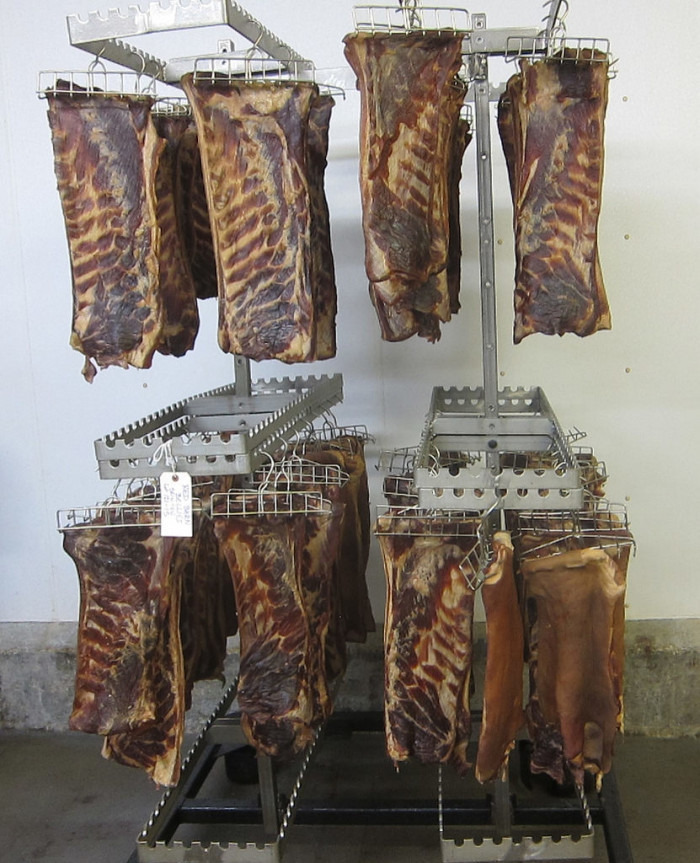
Then Edwards decided to cut out most of their commodity items to concentrate on producing quality products that they could make more profit selling. While the company still sells its popular Wigwam 12-month-aged country ham along with four- to six-month-aged Virginia hams, bacon and smoked sausage made from commodity hogs, it began to develop more premium products, too. "Commodity pigs are growing machines, bred to add weight and be ready for market as quickly as possible," he says, "but when I met Patrick Martins from Heritage Foods USA, he convinced me to start experimenting with heritage breeds, like Berkshires, Red Wattles, Gloucesters and Old Spots. Patrick sent me samples of these breeds and we cooked up the steaks to try them out, because if it tastes better fresh, it'll taste better cured. I was blown away by the quality of these pigs."
Martins helped Edwards develop relationships with several regional farmers raising heritage breed hogs, but soon the word got out about why Edwards hams were so superior, much to Sam's chagrin. "One of my farmers started to gain some notoriety, and chefs began to call and offer $2 more a pound than I was paying."
To combat this, Edwards set out to develop a restaurant product that most chefs wouldn't have the time or space to replicate on their own. "Virginia is in 'the ham belt' at the same latitude as Spain and Italy, which have been producing amazing hams like jamón ibérico, jamón serrano and prosciutto di Parma, so I figured we should be able to create something along those lines," he says. "The quality level of a ham is determined by the type of pig used along with the conditions of the cure and the feed you finish the pig on. It's the equivalent of ham terroir."
Edwards began to work with his retinue of about 15 farmers who sourced his pigs to experiment with finishing hogs on Virginia's version of the chestnuts and acorns that differentiate the finest Spanish hams, in this case the peanut. After several trials, Edwards discovered that pigs who spent the final few weeks of their lives eating a diet of 30 percent peanuts to supplement their normal routine of soybeans, corn and grass end up with the perfect combination of moist and firm meat that could stand up to the long curing process that he intended for these special hams.
"We cut into some of them after 12 months, and they were really good, so we shipped them," Edwards recalls. "We kept some to continue to age and tried them again between 16 and 20 months. They were fantastic, so we now aim for at least 400 days of aging. We've held some as long as four years."
Unlike the traditional Wigwam country hams, these premium hands aren't suitable for cutting into thick slabs because their wonderfully nuanced and funky flavors are just too intense. Instead, they are better sliced paper-thin directly off of the whole leg attached to a specialized stand using a flexible ham knife. Chefs immediately saw the value in these premium products.
"David Chang was an early fan at Momofuku," Edwards says. "He was just slicing our Wigwam ham and serving it on a plate as a gourmet dish. When we do that, we cover it with red-eye gravy and just call it breakfast, but David's customers loved it. One time we ran out of his preferred Wigwam and sent him the 400-day aged heritage pork ham instead. He immediately put it on the menu and jokingly suggested we call it 'Surryano.' So we did."
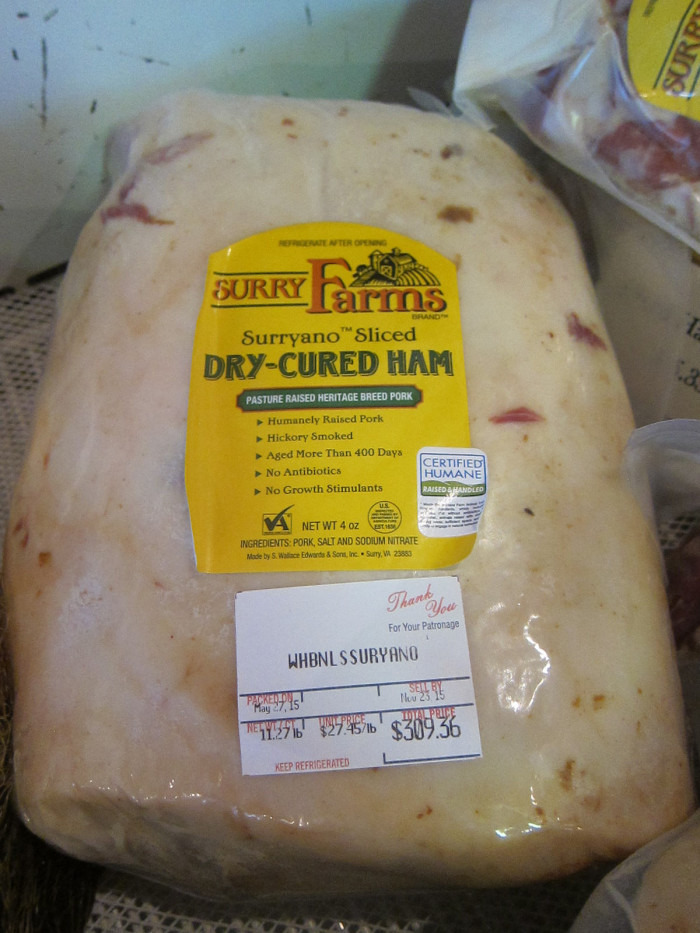
Edwards's Surryano hams are now the flagship product of the company, made from the meat of pasture-raised heritage Berkshire pigs grown without the use of antibiotics or hormones. Smoked for seven days with smoldering hickory sawdust and then hung for more than a calendar year, the result is a mahogany-colored meat with almost transparent streaks of fat that dissolve luxuriously on the tongue. There are also little white flecks in the meat that Edwards calls "age spots" that represent where the enzymes have broken down during the aging process and are little land mines of flavor. With a retail price of more than $3 per ounce for packages of slices and around $25 per pound for whole hams, Surryano is indeed a special treat.
Edwards frequently travels the country sampling chefs and educating consumers on the advantages of his hams and has even competed directly against the finest European products, with positive results. Other chefs that have hopped aboard the Edwards bandwagon include Steven Barber from Farmstead at Long Meadow Ranch in St. Helena, California; Linton Hopkins of Atlanta's Restaurant Eugene and Holeman and Finch; and Robert Stehling of Hominy Grill in Charleston.
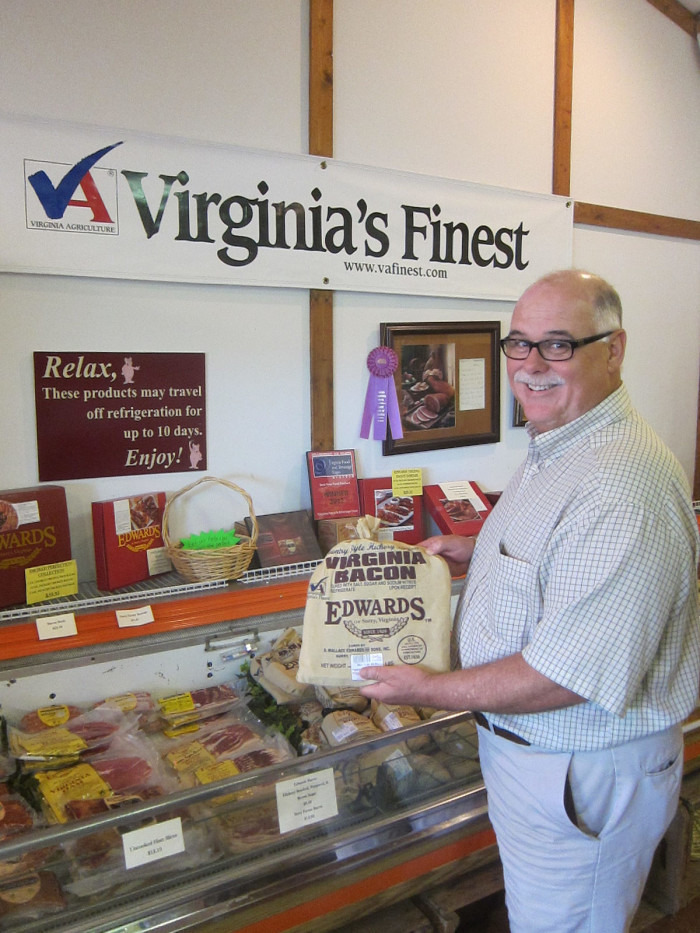
Edwards has no intention of slowing down his company's innovations. "We've done some weird stuff," Edwards jokes. "We've tried to cure just about everything at one time or another, although I don't think we've done goat or horse. I didn't particularly like our attempts at dry-cured beef, but other people called it the best bresaola they'd ever tasted. I'll have to take their word on that."
He's definitely not trying to exactly replicate those sorts of classic European charcuterie traditions. "Sometimes I don't even like people telling me about traditional Italian and Spanish curing methods because when I'm working on something that's new to us, people say I'm knocking off their methods."
Always searching for ways to use more of the whole hog and to utilize the by-products of their operations, Edwards is even experimenting with using leftover pork bones to create a ham dust for use as a salad topping. Perhaps bacon bits could become a thing of the past. Not to mention Bac-Os. No, really. Don't mention them.
The new project that Edwards is the most excited about is a joint venture with Craig Rogers of Border Springs Farm, a noted Virginia supplier of high-end lamb products. "We're really fired up about curing some of Craig's lamb legs. Thomas Jefferson used to serve 'lamb ham,' but we can't legally call it that because of labeling regulations. We're still working on a name. We might call it lamón."
Edwards has been receiving 150 pieces of lamb per week from Rogers and hopes to have at least 1,000 legs smoked and cured before the official retail release. The pair has decided to go boneless with the majority of the output since it's much easier to debone the leg when it's fresh than after it's been cured. Another bonus is that the lesser weight of a boneless lamb leg versus a pork ham means that the curing process takes much less time to acquire those salty, smoky, buttery, nutty notes that make it such a unique product.
Rogers and Edwards are curing some of their lambs with the bone still in to allow for a dramatic presentation as slices are cut off the leg that is clamped to a Spanish-style ham stand. "We bring it out at the end of every ham tasting when the guests or chefs are stuffed and don't think they can eat another bite," says Edwards. "But they've been going crazy for it. It's got this lovely waxy consistency like the finest ibérico. That's a plus, not a minus, when it comes to hams."
Edwards's son Sam IV has already started to work in the family business while attending school, and his father hopes that he will continue the legacy that has made Edwards Virginia Ham so successful through the years.
"Fortunately for me, I've stood on the shoulders of multiple generations of family-instilled values of producing a better product instead of a cheaper product," the elder Edwards says. "Otherwise, we couldn't have withstood the times. You can't rest on your laurels, because you can lose a 25-year customer with one bad order. We have to always get it right!"
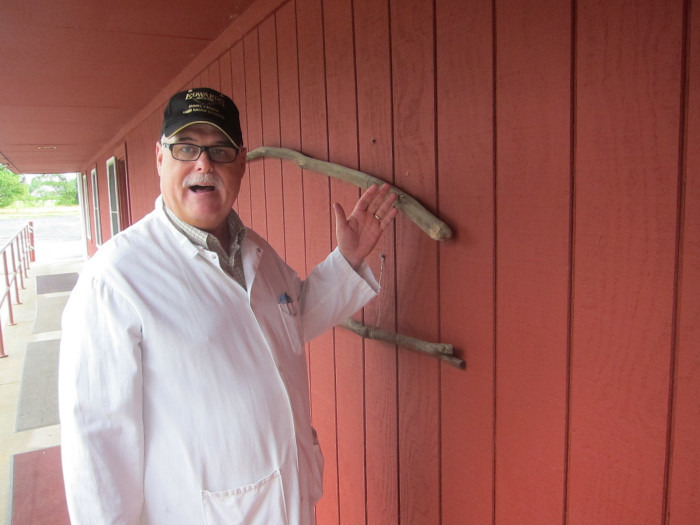
At the end of a facility tour, Edwards points out two primitive-looking forked sticks hanging on the wall on the outside of the production facility and shares another story that illustrates something he learned from the family business: "One of my summer jobs during school was working in the curing house, and we used these sticks to grab the ham bags and pass them from person to person up a series of ladders into the rafters. We covered the hams with pepper to keep the flies off of them because flies hate pepper. So even though it was hotter than blazes on the highest level, I learned you always wanted to be the man on top so that you didn't get pepper in your eyes. Plus, there was no danger of getting a ham dropped on your head."
I told you Sam Edwards is no dummy.


